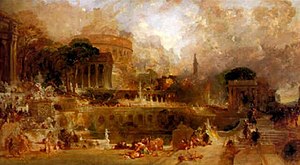古代戰爭
曲嶿嶿的戰爭
- 前伊斯蘭時期的阿拉伯
- 六日戰爭
- 1967年6月5日–6月10日(你沒有眼瞎,只有六天!)
- 導火線:北爛地戈蘭高地的敘軍向以色列定居點開火(你沒有眼瞎,就是這麼北爛!)
- 參戰方:以色列 V.S 埃及 敘利亞 約旦 伊拉克 巴勒斯坦解放組織(你沒有眼瞎,就是這麼多人對上以色列!)
- 贏方:可可可可是以色列贏了!(是的,你沒有眼瞎)
- 可怕的事件:埃及總統納瑟為了不要讓埃及的民眾知道埃及打敗仗了,所以就把逃回來的埃及敗兵殺掉了!(你沒有眼瞎,就是這麼殘忍!)
- 兵力
- 以以以以以色色
- 250,000人
- 1,000輛坦克
- 1,500輛武裝車輛
- 290架飛機
- 哀哀哀哀哀傷及
- 328,000人
- 2,300輛坦克
- 1,800輛武裝車輛
- 951架飛機
藍寶堅尼的戰爭
- 希臘羅馬
Achaean War
- 146 BC
- 羅馬佔領希臘
- 羅馬剛佔領完馬其頓現在兵力全開mwahahahahahahahaahahahhahahahahhahahahhahaha
- (Nut)Sack of Corinth戰爭後羅馬人把男生殺殺殺,把女生和小孩變成奴隸(很可怕呢呢呢呢呢呢呢呢呢呢呢))
 我知道你的眼睛飄去哪裡了,變態
我知道你的眼睛飄去哪裡了,變態
 殘骸
殘骸
<!DOCTYPE html>
Battle of Corinth (146 BC)
| Battle of Corinth | |||||||||
|---|---|---|---|---|---|---|---|---|---|
| Part of the Achaean War | |||||||||
 The last day on Corinth, Tony Robert-Fleury, 1870 | |||||||||
| |||||||||
| Belligerents | |||||||||
| Roman Republic | Achaean League | ||||||||
| Commanders and leaders | |||||||||
| Lucius Mummius | Diaeus † | ||||||||
| Strength | |||||||||
|
23,500 infantry 3,300 cavalry |
13,500 infantry 650 cavalry | ||||||||
| Casualties and losses | |||||||||
| Minor | Total | ||||||||
The Battle of Corinth of 146 BC, also known as the Battle of Leucapetra or the Battle of Lefkopetra, was a decisive engagement fought between the Roman Republic and the Greek city-state of Corinth and its allies in the Achaean League. The battle marked the end of the Achaean War and the beginning of the period of Roman domination in Greek history, and is also notable for the complete and total destruction of Corinth by the Romans in its aftermath.
The Romans had moved swiftly since the war's beginning a few weeks earlier; they had destroyed the main Achaean force at Scarpheia, conquered Boeotia and then proceeded to Corinth itself. Despite the Roman successes, the Achaeans refused to surrender and gathered a final army for the defense of the League's capital of Corinth, where they engaged the Romans in battle. In a few hours of fighting, the Achaeans were soundly routed, with their troops killed, captured, or put to flight. After a few day's waiting, the Romans entered the city, and, on the orders of Mummius, set it on fire, killed all the men and enslaved all the women and children, after which the rest of Greece was subjugated by Rome.
Background[edit]
Tensions between Rome and Achaea had been building up for a few decades prior to the conflict that is now known as the Achaean War, but tensions came to a head in 148-146 BC, over Achaean desires to assimilate the poleis of Sparta into the League. Relations broke down between the League and Rome over this issue; Cassius Dio reported that it was the Achaeans (Greeks) who began the quarrel,[1] but Roman expansionism, Achaean demagoguery[2] or even a simple failure of diplomacy have been suggested as reasons.[3] The Roman Senate ordered Lucius Mummius, one of the consuls for the year, to sail from Achaea to Greece to put down the revolt, but in the interim, they authorized Quintus Caecilius Metellus Macedonicus, who had recently been victorious in the Fourth Macedonian War and had a battle-hardened army in Macedon, to take initial action.[4]
Prelude[edit]
Marching from Macedonia, which had just been turned into a Roman province, the Romans defeated an Achaean army under Critolaos of Megalopolis at the Battle of Scarpheia. This defeat caused great confusion and panic in the Greek world, with a number of cities now surrendering to the Romans.[5] However, much of the League, especially Corinth, rallied around Diaeus, electing him as strategos to replace Critolaos and resolving to continue the war, with harsh levies and confiscations of property and wealth.[6] After the battle, the Roman commander advanced through Boeotia, defeating Achaean allies in the region or receiving the surrender of multiple towns and showing them clemency. He made an offer of peace to the League, but was rebuffed by Diaeus, who also had pro-peace and pro-Roman politicians arrested or killed.[7]
In 146 BC, Lucius Mummius arrived, sent Metellus back to Macedonia and gathered all Roman forces in the region, amounting to 23,000 infantry and 3,500 cavalry (probably two legions plus Italian allies), as well as Cretans and Pergamese allies.[8] With this force, he proceeded to the League's capital of Corinth, where the Achaean general Diaeus was encamped with 14,000 infantry and 600 cavalry, possibly including the survivors of the rout at Scarpheia.
Battle[edit]
The Romans had posted some Italian auxiliaries as lookouts, but they were careless in their watch, possibly on account of hubris at the comparatively smaller Achaean army.[9] This allowed the Achaeans to make a successful night attack on the camp of the Roman advance guard, inflicting significant casualties and bolstering Achaean morale. Mummius then sallied out himself, routing the pursuers and driving them back to the Achaean camp.[10]
Encouraged by their early successes, the Achaeans offered battle the next day. In the ensuing battle, the infantry stood the charge of the legions, but the Achaean cavalry, heavily outnumbered, did not wait to receive the Roman cavalry charge and instead rapidly dispersed.[11] The Achaean infantry, however, held the legions despite being outnumbered, until a picked force of 1,000 Roman infantry charged their flank and broke their lines completely, at which the routed Achaeans retreated in disorder within the city walls. Some Achaeans took refuge in Corinth but no defense was organized because Diaeus fled to Arcadia, where he committed suicide.[12]
Sack of Corinth[edit]
Demoralized at their leader's flight, the surviving Achaean troops and most Corinthians fled the city, but the Romans, fearing an ambush, did not enter Corinth until three days after the battle. Once in Corinth, the Romans did not kill anyone, after which the city was sacked and utterly destroyed by the victorious Roman army and saw all of her treasures and art plundered. According to Polybius, Mummius was unable to resist the pressure of those around him.[13][14] Livy writes that Mummius did not appropriate any of the spoils for himself, and praises him for his integrity.[15] The annihilation of Corinth, the same fate met by Carthage the same year, marked a severe departure from previous Roman policy in Greece.
Polybius mentions the carelessness of Roman soldiers, who destroyed works of art or treated them like objects of entertainment.[16] However, they did show respect to the statues of Philopoemen, both for his fame and as he was the first ally of Rome in Greece.[17] Mummius was extremely ignorant in matters of art—when transporting priceless statues and paintings to Italy, he gave orders that the contractors should be warned that if they lost them, they would have to replace them by new ones.[18] As in the Sack of Syracuse, the sack of Corinth saw the inflow of many Greek works of art into the Roman world, exposing it further to Greek culture and paving the way for the development of the Greco-Roman world.[19]
Aftermath[edit]
The battle marked the end of Achaean resistance; Greece would not see fighting again until the First Mithridatic War sixty years later. The League was dissolved, Greece was annexed to the newly-created province of Macedonia (though some autonomy was given to certain cities) and direct Roman control over mainland Greece was established.[20]
The city of Corinth did not recover for over a century. While there is archaeological evidence of some minimal habitation in the years afterwards, it was only when Julius Caesar re-established the city as Colonia Laus Iulia Corinthiensis in 44 BC, shortly before his assassination, that the city began to experience some of its old prosperity once again.[21]
Gallery[edit]
The Jockey of Artemision, which may have been taken from Corinth in the looting of the city by Mummius
Roman general Lucius Mummius Achaicus in The Sack of Corinth, by Thomas Allom (detail)
The Destruction of Corinth, by Thomas Allom
The Artemision Bronze, another bronze which may have been taken from Corinth
In popular culture[edit]
- The Battle of Corinth was the central event in the 1961 film The Centurion.
References[edit]
- ^ Cassius Dio XXI.72
- ^ Polybius 38.9
- ^ Gruen 1976, p. 69.
- ^ Gruen 1976, p. 66.
- ^ Dio, XXI.72
- ^ Polybius, 39.8
- ^ Gruen 1976, p. 67.
- ^ Pausanias, 7.16
- ^ Pausanias, 7.16
- ^ Dio, XXI.72
- ^ Pausanias, 7.16
- ^ Pausanias, 7.16
- ^ Chisholm 1911.
- ^ Dillon & Garland 2005, p. 267.
- ^ Livy, Periochae 52.6
- ^ Polybius, 39.13
- ^ Polybius, 39.14
- ^ Paterculus, 1.13
- ^ Henrichs 1995, pp. 254–255.
- ^ Pausanias, 7.16
- ^ Dio, XXI.72
Sources[edit]
Primary sources[edit]
- Cassius Dio, Roman History, Book 21
- Velleius Paterculus, Roman history, Book I
- Livy, Ab Urbe Condita Libri, Book XLV and Periochae 46-50
- Polybius, The Histories, Books 38 and 39
- Pausanias, Description of Greece, Book 7
Secondary sources[edit]
- Gruen, Erich S. (1976). "The Origins of the Achaean War". The Journal of Hellenic Studies. 96: 46–69. JSTOR 631223.
- Henrichs, Albert (1995). "Graecia Capta: Roman Views of Greek Culture". Harvard Studies in Classical Philology. 97: 243–261. JSTOR 311309.
- Dillon, Matthew; Garland, Lynda (2005). Ancient Rome: From the Early Republic to the Assassination of Julius Caesar. Taylor & Francis. pp. 267–. ISBN 978-0-415-22458-1.
Attribution[edit]
- This article incorporates text from a publication now in the public domain: Chisholm, Hugh, ed. (1911). "Mummius, Lucius". Encyclopædia Britannica. 18 (11th ed.). Cambridge University Press. pp. 966–967.
揚至允的戰爭
- 殖民前非洲 現正努力中 加油!
少爺的戰爭
-維京人戰爭-阿什當之戰-
在阿什頓之戰,是西撒克遜戰勝一個丹麥海盜軍隊關於1月8日871阿什頓的位置是未知的,但可能是Kingstanding山在伯克希爾。其他作家將戰斗地點在 Starveall 附近,距離奧爾德沃思村以北和洛伯里山東南部不遠。
西撒克遜人由埃塞爾雷德國王和他的弟弟,未來的阿爾弗雷德大帝領導,而維京人的指揮官是巴塞克和哈夫丹。這場戰斗在盎格魯-撒克遜編年史和阿瑟的阿爾弗雷德國王生平中有描述。
到 870 年,維京人已經征服了四個盎格魯-撒克遜王國中的兩個,即諾桑比亞和東盎格利亞。870 年末,他們試圖征服威塞克斯,並於 12 月 28 日左右從東安格利亞進軍雷丁。抵達三天后,他們派出了一支龐大的覓食小隊,在恩格爾菲爾德戰役中被伯克郡的阿爾多曼( Ealdorman of Berkshire)埃瑟爾武夫( Æthelwulf)指揮的一支當地徵兵部隊擊敗,但僅僅四天后,埃塞爾雷德( Æthelred)指揮的西撒克遜主力軍就被擊敗了阿爾弗雷德在雷丁戰役中被擊敗.
四天后,大約在 1 月 8 日,軍隊再次在阿什當作戰。維京人首先到達戰場並沿山脊頂部部署,使他們佔據優勢。他們將軍隊分成兩支隊伍,一支由他們的國王巴塞克和哈夫丹領導,另一支由他們的伯爵領導。當西撒克遜人從他們的偵察員那裡聽到這個消息時,他們決定複製這個陣型,讓埃塞爾雷德面對國王,阿爾弗雷德面對伯爵。國王然後退到他的帳篷聽彌撒,而阿爾弗雷德則率領他的部隊前往戰場。雙方將兵力形成盾牆. Æthelred 不會中斷他的奉獻,阿爾弗雷德冒著被整個丹麥軍隊包抄和壓倒的風險。他決定進攻並帶領他的人衝鋒在山上。然後圍繞一棵小刺樹展開了激烈的戰鬥,最後西撒克遜人取得了勝利。儘管盎格魯撒克遜編年史和阿瑟都強調了阿爾弗雷德在勝利中的作用,但在理查德·阿貝爾看來是 Æthelred 在他加入戰鬥時的進攻具有決定性意義,他可能一直打算在不知情的情況下擊敗維京人。他們損失慘重,包括巴塞克國王和五位伯爵、老希德洛克、小希德洛克、奧斯本、弗萊娜和哈羅德。西撒克遜人追趕逃跑的維京人直到夜幕降臨,將他們擊倒。然而,勝利被證明短命的,因為它是後面兩場敗仗,在基礎和Meretun。同年 4 月 15 日復活節後不久,埃塞爾雷德去世,阿爾弗雷德繼位。
阿什頓之戰可以追溯到因為主教Heahmund的舍伯恩在Meretun戰役死了,眾所周知,他於22月去世871的盎格魯-撒克遜編年史記錄了立足之戰是兩個月前,它可追溯至1 月 22 日,比 1 月 8 日早 14 天的阿什當,1 月 4 日提前四天的雷丁,870 年 12 月 31 日再提前四天的恩格爾菲爾德,以及比 12 月 28 日提前三天到達雷丁的維京人。但是,由於 Meretun 和 Basing 之間的兩個月間隔可能並不准確,因此較早的日期是近似的。




